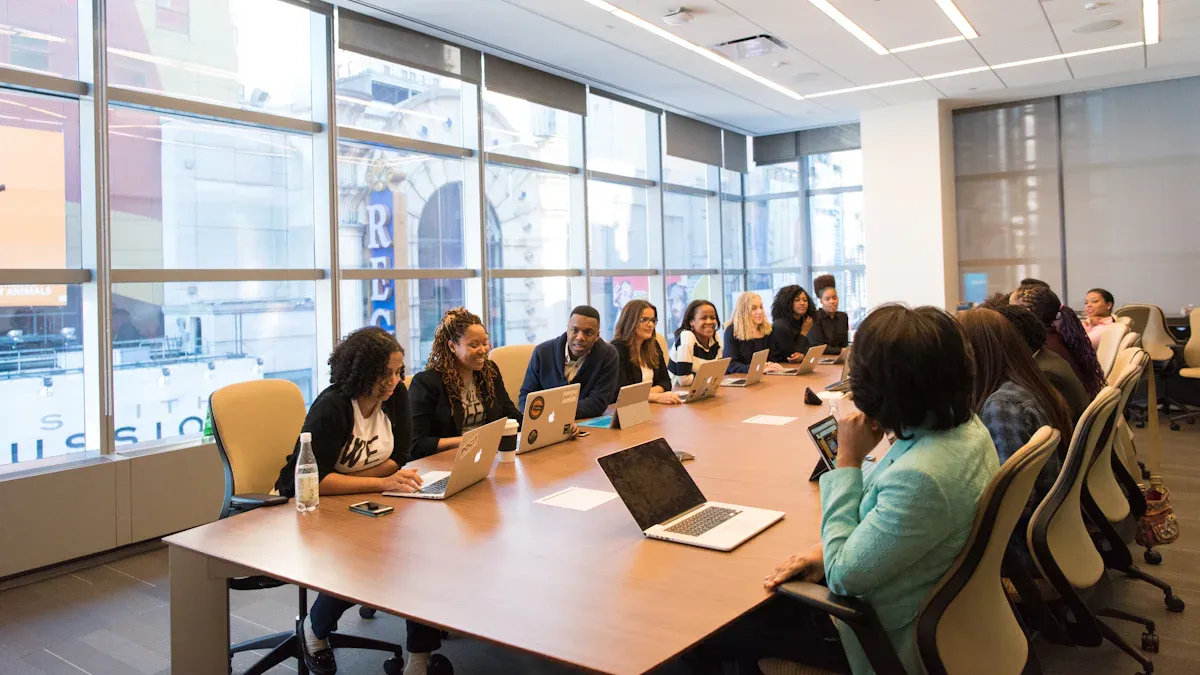Diversity Recruitment Explained and Why It Matters

Diversity recruitment is your opportunity to build a workforce that reflects the world’s rich variety of identities and experiences. In 2025, this effort matters more than ever. Organizations now treat inclusion and equity as essential business strategies, embedding them into broader goals like environmental and social governance. Companies also use an intersectional approach to understand how identities interact with systems of power. These shifts show that diversity recruitment isn’t just a trend—it’s a necessity for creating workplaces where everyone thrives.
Key Takeaways
Diversity hiring creates a team with different backgrounds and ideas. This helps with creativity and makes everyone feel included.
Write job ads that welcome all kinds of people. Use friendly words and show you care about diversity.
Use fair hiring steps like planned interviews and hiding names on resumes. This makes the process equal for everyone.
Use tools like AI to find and fix biases. This helps you reach more diverse job seekers.
Build a welcoming workplace by offering diversity lessons and mentors. This helps workers feel important and confident.
What is Diversity Recruitment?
Definition and Core Principles
Diversity recruitment is the intentional process of building a workforce that values and reflects different perspectives, backgrounds, and experiences. It goes beyond filling quotas. Instead, it focuses on creating an environment where everyone feels valued and empowered to contribute. At its core, diversity recruitment is about fairness, equity, and inclusion. You aim to ensure that opportunities are accessible to all, regardless of race, gender, age, or other identities. This approach fosters a workplace where innovation thrives and individuals feel a sense of belonging.
Key Components
Inclusive Job Descriptions
Crafting inclusive job descriptions is a foundational step in diversity recruitment. You should use language that welcomes candidates from all walks of life. Avoid jargon or phrases that might unintentionally exclude certain groups. For example, instead of saying "native English speaker," you could write "proficient in English." Highlight your organization's commitment to diversity and inclusion to attract a broader range of applicants.
Proactive Sourcing of Diverse Talent
Waiting for candidates to come to you limits your reach. Proactively sourcing diverse talent means seeking out candidates from underrepresented groups. You can connect with professional organizations, attend diversity-focused career fairs, or engage with online communities. By expanding your recruitment channels, you open the door to a wider pool of qualified candidates.
Bias-Free Hiring Practices
Unconscious bias can influence hiring decisions, even when you have the best intentions. Implementing bias-free hiring practices helps ensure fairness. Use structured interviews with standardized questions to evaluate candidates consistently. Blind resume reviews, where identifying information is removed, can also reduce bias. Training hiring managers to recognize and address their biases is another critical step.
How It Differs from Traditional Recruitment
Diversity recruitment stands apart from traditional recruitment in several ways:
Intentional Efforts: You actively design strategies to attract candidates from diverse backgrounds, unlike traditional methods that may overlook this priority.
Broader Recruitment Channels: Diversity recruitment leverages diverse organizations, social media, and non-traditional platforms, while traditional recruitment often sticks to conventional job boards.
Training for Hiring Managers: You emphasize training to help hiring managers identify and mitigate biases, which is rarely a focus in traditional recruitment.
By embracing these differences, you can create a hiring process that aligns with modern values and workplace expectations.
Why Diversity Recruitment Matters in 2025
The Evolving Workplace
Shifting Demographics
The workforce is undergoing significant changes. By 2025, two major demographic shifts will reshape workplaces worldwide: an aging population and a younger, more diverse generation entering the job market. These shifts mean you’ll need to adapt your hiring strategies to attract and retain talent from a broader range of backgrounds. Ignoring these changes could leave your organization struggling to stay competitive in a rapidly evolving world.
Technology's Role in Recruitment
Technology is revolutionizing how you approach diversity recruitment. Tools like artificial intelligence (AI) and data analytics can help you identify and eliminate biases in hiring. For example, AI-driven recruitment has been shown to increase the selection of women and minorities by 27% compared to traditional methods. Inclusive language in job postings can boost applications from underrepresented groups by 24%. Companies like Unilever have seen a 50% rise in diverse applicants by adopting these strategies. Virtual reality (VR) interviews are another game-changer, with organizations reporting a 30% increase in diversity among new hires. These innovations make it easier than ever to build a more inclusive workforce.
Societal Expectations
Society expects businesses to lead the way in promoting equity and inclusion. Companies with diverse teams are 1.7 times more likely to be innovation leaders and 70% more likely to capture new market opportunities. Additionally, organizations with higher gender diversity are 25% more likely to financially outperform their competitors. Meeting these expectations isn’t just about doing the right thing—it’s about staying relevant in a world that values diversity more than ever.
The Business Case
Innovation and Creativity
Diverse teams bring fresh perspectives that drive innovation. Companies with diverse workforces are 1.7 times more likely to lead in their markets. They’re also 70% more likely to seize new opportunities. This creativity translates into tangible results, like a 19% increase in revenue for organizations with diverse management teams.
Better Decision-Making
When you bring together people with different experiences, you get better decisions. Diverse teams analyze problems from multiple angles, leading to more effective solutions. This approach not only improves outcomes but also fosters a culture of collaboration and respect.
Market Competitiveness
Diversity recruitment gives you a competitive edge. Companies with higher ethnic and cultural diversity are 36% more profitable than those with lower diversity levels. A diverse workforce helps you connect with a broader customer base, making your business more adaptable and resilient in a global market.
Benefits of Diversity Recruitment

For Businesses
Stronger Employer Branding
Your company’s reputation matters more than ever. Diversity recruitment strengthens your employer branding by showcasing your commitment to inclusion. Today, candidates actively research potential employers for diversity policies. In fact:
45% of men and 54% of women consider diversity policies before applying.
78% of employees value workplaces that prioritize equality.
When you embrace diversity, you attract top talent and stand out as a forward-thinking organization. Sundar Pichai, CEO of Google, said it best:
"A diverse mix of voices leads to better discussions, decisions, and outcomes for everyone."
This commitment not only enhances your brand but also positions you as a leader in innovation and inclusivity.
Broader Market Reach
A diverse workforce helps you connect with a wider audience. Employees from different backgrounds bring unique insights into customer needs and preferences. Companies with higher ethnic and cultural diversity are 36% more profitable than those with lower diversity levels. By embracing diversity, you unlock new opportunities and strengthen your market position.
For Employees
Job Satisfaction
Diversity recruitment creates workplaces where employees feel valued and respected. Inclusive environments boost morale and engagement. Employees who feel recognized for their unique contributions are more motivated and committed. This leads to:
Higher productivity.
Improved performance.
Reduced turnover.
When you prioritize inclusivity, you foster a culture where employees thrive.
Sense of Belonging
Belonging is the cornerstone of a successful workplace. Chelsea C. Williams, founder of Reimagine Talent Co., defines belonging as the feeling of being seen, valued, and respected. She explains that belonging emerges when diversity, equity, and inclusion intersect. By focusing on diversity recruitment, you create an environment where employees feel connected and protected. This sense of belonging drives loyalty and collaboration.
For Society
Reducing Inequality
Diversity recruitment plays a vital role in reducing inequality. By providing equal opportunities, you help bridge gaps in employment and representation. This effort uplifts underrepresented communities and fosters a more equitable society.
Promoting Social Cohesion
When workplaces reflect the diversity of society, they promote understanding and unity. Employees from different backgrounds learn from one another, breaking down stereotypes and building trust. This ripple effect extends beyond the workplace, contributing to a more cohesive and inclusive world.
Challenges in Diversity Recruitment
Common Obstacles
Unconscious Bias
Unconscious bias often creates invisible barriers in recruitment. Without realizing it, you might favor candidates who share your background or experiences. This bias can limit opportunities for underrepresented groups. To address this, you can:
Conduct awareness training to help hiring teams recognize and challenge their biases.
Standardize interviews by asking all candidates the same structured questions.
Use blind screening methods to remove identifying details from resumes.
Even the language in job descriptions can unintentionally exclude certain groups. By using inclusive wording, you ensure that all candidates feel encouraged to apply.
Limited Talent Pools
Finding diverse talent can feel challenging, especially in industries with historically low representation. Ethnic and cultural disparities may also lead to misunderstandings within teams if not managed effectively. Expanding your recruitment channels is key. Partner with organizations that support underrepresented groups or attend diversity-focused job fairs. These efforts broaden your reach and help you build a more inclusive workforce.
Misconceptions
"Lowering Standards" Myth
A common misconception is that diversity recruitment sacrifices quality for representation. Some believe companies hire based on identity rather than qualifications, which diminishes the accomplishments of diverse hires. In reality, diversity recruitment ensures all candidates meet the job requirements. It focuses on hiring the best talent while creating equal opportunities for everyone.
Resistance to Change
Change often meets resistance, especially when it challenges long-standing practices. Employees may fear that diversity initiatives will disrupt workplace dynamics. Open communication can ease these concerns. For example, Delta Airlines shifted from quotas to storytelling, which humanized their efforts and increased acceptance by 22% over two years. Workshops where employees voice concerns also foster understanding and commitment.
Overcoming Challenges
To overcome these obstacles, you need a proactive approach. Start by creating diverse hiring panels to counterbalance individual biases. Organize workshops to address misconceptions and encourage open dialogue. Initiatives like Salesforce’s 'Ohana Culture,' which includes regular feedback sessions, have shown a 20% increase in employee satisfaction. By prioritizing inclusivity and communication, you can turn challenges into opportunities for growth.
How to Implement Diversity Recruitment Strategies

Inclusive Recruitment Processes
Bias Awareness Training
Creating an inclusive recruitment process starts with addressing unconscious bias. You may not realize it, but biases can influence hiring decisions and limit opportunities for underrepresented groups. To combat this, begin with a comprehensive audit of your current hiring practices. Identify areas where bias might exist and take steps to eliminate it.
Training your hiring team is essential. Equip them with tools to recognize and challenge their biases. Workshops on cultural competence can also help your team understand and value diverse perspectives. Structured interviews are another powerful tool. By asking all candidates the same set of questions, you ensure fairness and consistency in evaluations. Diverse interview panels can further reduce bias by bringing varied perspectives to the table.
Technology for Fair Hiring
Technology can revolutionize how you approach fair hiring. AI tools can analyze job postings to remove biased language, ensuring they appeal to a broader audience. Blind resume reviews, powered by AI, can strip personal identifiers like names or photos, allowing you to focus solely on qualifications.
You can also use AI to evaluate interview questions for neutrality. This ensures that all candidates face the same level of scrutiny. Additionally, recruitment platforms can target diverse talent pools with personalized outreach, helping you connect with candidates from underrepresented groups. By leveraging these tools, you create a hiring process that prioritizes equity and inclusivity.
Partnering with Talent Networks
Partnering with talent networks is a game-changer for diversity recruitment. These organizations specialize in connecting employers with diverse professionals. They offer access to extensive networks and deep expertise in underrepresented talent pools.
Boutique recruiting firms, for example, can tailor strategies to align with your diversity goals. They also implement measures to reduce unconscious bias, ensuring fair evaluations. Long-term partnerships with these networks provide ongoing feedback, helping you refine your recruitment efforts over time. By collaborating with these experts, you can build a workforce that reflects the richness of society.
Tracking Diversity Metrics
Measuring your progress is crucial for success. Start by tracking the percentage of women and minorities in your applicant pool. This metric reveals how inclusive your hiring practices are. Monitor the diversity of candidates at different stages of the hiring process to identify potential drop-off points.
Retention rates among diverse hires are another key indicator. High retention suggests that your workplace fosters inclusion and belonging. Regular employee surveys can provide additional insights into how your team perceives your diversity efforts. By analyzing these metrics, you can continuously improve your strategies and create a more equitable workplace.
Building an Inclusive Culture
Building an inclusive culture is the cornerstone of successful diversity recruitment. It’s not just about hiring diverse talent; it’s about creating an environment where everyone feels valued and empowered to contribute. You can take several steps to foster inclusivity in your workplace.
Use unbiased language in job advertisements to attract a broader range of candidates. Words matter, and inclusive language ensures no one feels excluded before they even apply.
Implement blind recruitment processes to eliminate unconscious bias. Removing personal identifiers from resumes allows you to focus solely on skills and qualifications.
Provide diversity training for hiring managers. This equips them with the tools to understand and embrace inclusive practices.
Mentorship and internship programs tailored to underrepresented groups can also make a significant impact. These initiatives provide opportunities for growth and help bridge gaps in representation. When you invest in these programs, you’re not just supporting individuals—you’re building a pipeline of diverse talent for the future.
Comprehensive policies that cater to diverse employee needs are equally important. Flexible working arrangements, inclusive healthcare options, and parental leave policies show your commitment to supporting all employees. These measures create a workplace where everyone can thrive.
Tip: Inclusivity starts with leadership. When leaders model inclusive behavior, it sets the tone for the entire organization.
By taking these steps, you create a culture where diversity isn’t just a goal—it’s a reality. Employees feel a sense of belonging, and your organization becomes a place where innovation and collaboration flourish. Inclusivity isn’t just good for business; it’s the right thing to do. 🌟
Diversity recruitment is more than a hiring strategy; it’s a transformative approach to building a thriving workplace in 2025. Its benefits ripple across businesses, employees, and society. Companies with diverse teams are 36% more profitable and 25% more likely to outperform competitors. Employees feel valued and empowered, fostering engagement and innovation. Society benefits from reduced inequality and stronger social cohesion.
To achieve these outcomes, you must adopt proactive strategies. Build inclusive cultures, track diversity metrics, and leverage technology to eliminate bias. With 93% of c-suite leaders recognizing the importance of diversity, now is the time to act. By prioritizing inclusivity, you create a workplace where everyone can succeed. 🌟
FAQ
What is the first step to start diversity recruitment?
Begin by assessing your current hiring practices. Identify gaps in representation and inclusivity. Then, set clear diversity goals. Use tools like inclusive job descriptions and bias-free hiring processes to attract diverse talent. Remember, small steps lead to big changes. 🌟
How can you measure the success of diversity recruitment?
Track metrics like the diversity of applicants, hires, and retention rates. Conduct employee surveys to gauge inclusivity and belonging. Use these insights to refine your strategies. Success isn’t just about numbers—it’s about creating a workplace where everyone thrives.
Does diversity recruitment mean lowering hiring standards?
Absolutely not! Diversity recruitment focuses on finding the best talent while ensuring equal opportunities. It’s about removing barriers, not lowering expectations. You hire based on skills and qualifications, creating a fair and inclusive process for all candidates.
How can technology help with diversity recruitment?
Technology eliminates bias and expands your reach. AI tools can analyze job postings for inclusive language. Blind resume reviews ensure fair evaluations. Recruitment platforms connect you with underrepresented talent pools. Use these tools to build a more equitable hiring process. 🤖✨
Why is leadership important in diversity recruitment?
Leaders set the tone for inclusivity. When they champion diversity, it inspires the entire organization. Inclusive leadership fosters trust, collaboration, and innovation. By modeling these values, leaders create a culture where everyone feels valued and empowered.
See Also
Using AI For Fairness In The Hiring Process
Overcoming Language Challenges With Applicant Tracking Systems
Boosting Transparency In Recruitment Through Tracking Systems
Maximizing Recruitment Success With Applicant Tracking Insights
Moka Recruiting's Global Launch: Enhancing International Recruitment
From recruiting candidates to onboarding new team members, MokaHR gives your company everything you need to be great at hiring.
Subscribe for more information

